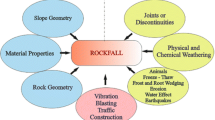Conclusions
-
1.
For evaluating the stability of rocks in underground workings and predicting stability a differential consideration of the effect of geological factors and especially jointing is necessary.
-
2.
It was established that the formation of falls in underground workings is due to the presence of a fall-hazardous model of joints. A rock block bounded by this model and located within the arch of the working is fall-hazardous. The shape and spatial arrangement of fall-hazardous blocks are predetermined by the joint systems developed in the rock mass. If the shape of the base of the fall-hazardous block is not isometric, then the orientation of the working influences the formation of the fall-hazardous model.
-
3.
It was established that mineral filling of joints as a calcite coating does not have a strengthening effect on the rock. Falls are confined both to joints with and without calcite. The presence of a fall-hazardous model is determining. Joints with loose filling (clay gouge, rubble) not forming a fall-hazardous model do not participate in fall formation. In the absence of a fall-hazardous model the factor of the length and density of joints does not have an effect on fall formation.
-
4.
A timely analysis of the rock mass around the tunnel by a geologist in the working under construction makes it possible to give recommendations on the use of temporary support and increases the safety and effectiveness of tunneling operations.
Similar content being viewed by others
Literature cited
E. M. Pashkin and B. D. Mal'tsev, “Effect of the structure of the rock structure on its stability in tunnels,” Tr. Gidroproekta, No. 43 (1974).
E. M. Pashkin, “Evaluation of rock stability in tunnels of the Nurek hydroelectric station,” Tr. Gidroproekta, No. 43 (1974).
E. M. Pashkin and N. F. Lomonosov, “Effect of certain geological factors on rock stability when driving underground structures,” Tr. Gidroproekta, No. 49 (1976).
E. M. Pashkin, “Principles of predicting rock stability when driving hydraulic tunnels in fold-mountain regions,” Tr. Gidroproekta, No. 49 (1976).
B. D. Mal'tsev, “Analysis of the structural conditions of rock masses when evaluating and predicting rock stability in underground workings of hydraulic structures in foldmountain regions,” Tr. Gidroproekta, No. 49 (1976).
Guide to the Design of Hydraulic Tunnels [in Russian], Moscow (1982).
N. F. Lomonosov, “Zone of tension at the site of the Nurek hydroelectric station,” in: Engineering-Geologic Characteristics of the Natural Conditions of Tadzhikistan [in Russian], Donish, Dushanbe (1978).
Additional information
Translated from Gidrotekhnicheskoe Stroitel'stvo, No. 3, pp. 27–30, March, 1983.
Rights and permissions
About this article
Cite this article
Finagina, G.G. Effect of rock jointing on the stability of underground workings of the Nurek hydroelectric station. Hydrotechnical Construction 17, 137–142 (1983). https://doi.org/10.1007/BF01425191
Issue Date:
DOI: https://doi.org/10.1007/BF01425191




